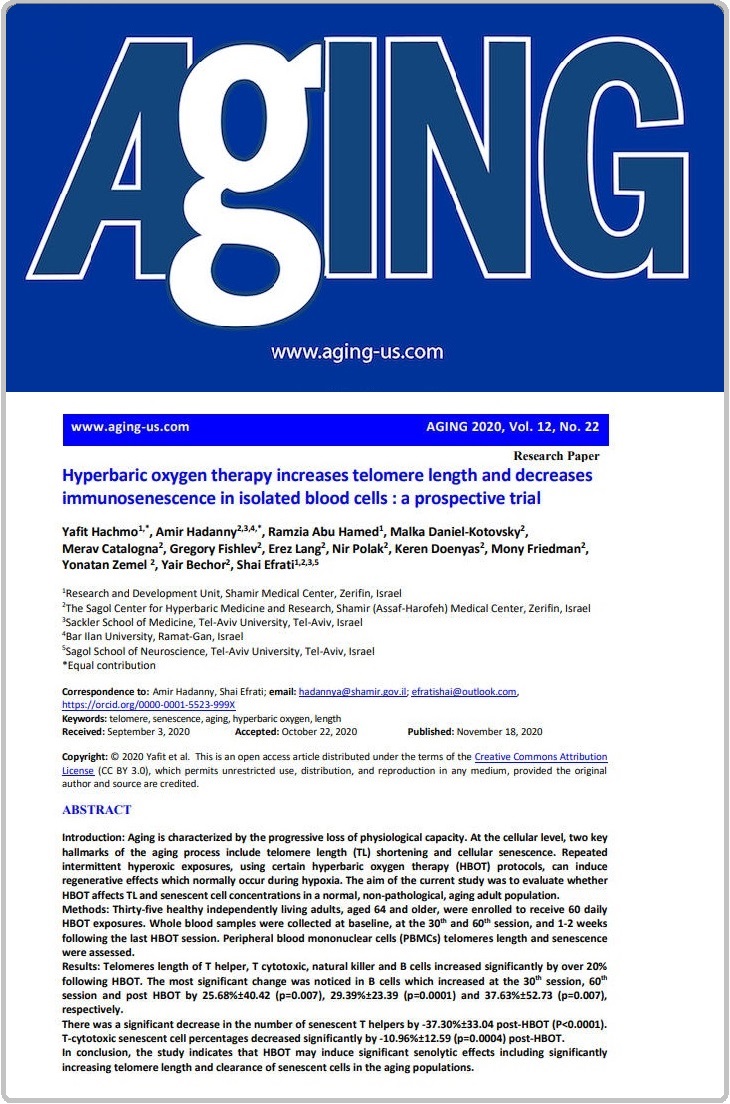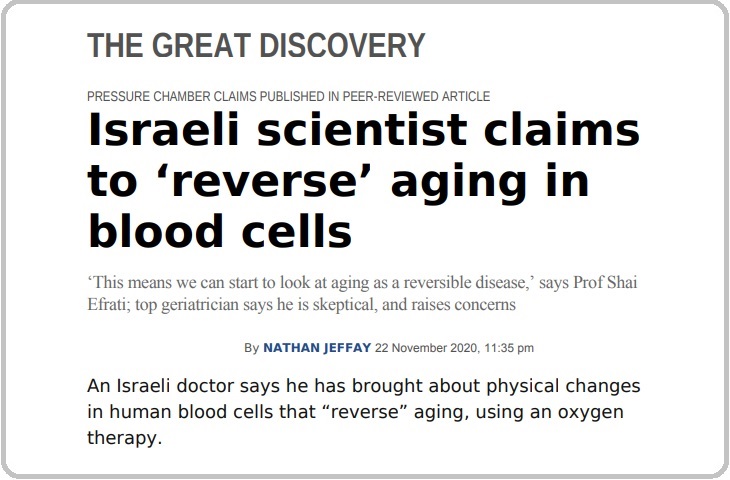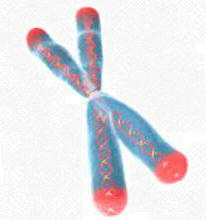Documents

Israeli scientist claims to "reverse" the aging of blood cells "This means that we can start to consider aging as a reversible disease," says Professor Shai Efrati. An Israeli doctor says he has caused physical changes in human blood cells that "reverse" aging using oxygen therapy. Shai Efrati reported in a peer-reviewed journal article published Nov. 18 that his research team's 60-day therapy lengthened telomeres, the structures at the ends of chromosomes, on average by more than a fifth part. He claims this represents a “holy grail” in the battle against aging. We try to address aging with physical exercise and dietary changes, but this only slows the deterioration," Efrati told The Times of Israel. “We are showing that we can turn back the biological clock and improve the quality of blood cells.
This means that we can begin to consider aging as a reversible disease.”
The Tel Aviv University associate professor said that in the
near future, large numbers of people could enroll in the
therapy he gave to his trial subjects: a course of sessions
in a pressurized (or hyperbaric) chamber, breathing oxygen
pure for a few weeks.
The Sagol Center for Hyperbaric Medicine and Research, a
nonprofit at Shamir Medical Center near Rishon Lezion, which
he directs, offers his oxygen protocol to companies outside
Israel.
At the Aviv Clinic near a Florida retirement home, which
offers it as an answer to aging. Efrati is a medical advisor
at the clinic.
Efrati reported that, in addition to lengthening telomeres,
his therapy led to a decrease in senescent cells, whose
population is believed to correlate with the onset of
various diseases.
Efrati's new study was written after he recruited 35 people
over the age of 64 and took blood samples. He then gave some
of them a 60-day treatment, during which they spent time in
a hyperbaric chamber, breathing pure oxygen for part of the
time.
In a previous study published
in July, he stated that the therapy improves cognitive
function. In his latest research, he examined telomeres,
which are like protective caps on the ends of chromosomes.
They shorten with age and some studies indicate that their
length can affect the rate of physical aging and the
appearance of age-related diseases.
He excluded the results of nine of his participants from his
telomere analysis, five because they did not meet the
initial assessments and four because their blood samples
were of poor quality. For the analysis of senescent cells he
excluded 15 participants, five because they did not comply
with the initial evaluations and 10 because their blood
samples were of poor quality.
Among other study participants, there was an increase in
telomere length, averaging more than 20 percent, and a
reduction in senescent cells on a similar scale, Efrati
reported.
"Researchers around the world are trying to develop
pharmacological and environmental interventions that allow
telomere lengthening," Efrati said. "Our hyperbaric oxygen
therapy protocol was able to achieve this, demonstrating
that the aging process can be reversed at the basic
cellular-molecular level"
Now you can read the full paper of this great discovery,
Shorter white blood cell telomeres linked to
higher dementia risk
by British Medical Journal
Human chromosomes (grey) capped by telomeres (white).
Credit: PD-NASA; PD-USGOV-NASA
Shorter telomeres on the ends of white blood cell
chromosomes may signal a heightened dementia risk, suggest
the results of a large, long-term study published online in
the journal General Psychiatry.
They are associated with smaller total and white matter
brain volume, which helps the body process information, and
may be a predictor of future brain health, say the
researchers.
A telomere–the equivalent of a shoelace cap—is intended to
prevent the loss of coded DNA by a chromosome fraying or
unraveling when it replicates.
Each time a cell divides, chromosomes replicate, and
telomeres shorten slightly, so telomeres have emerged as a
promising marker for cellular aging and the risk of
age-related diseases, note the researchers. But studies
looking at telomere length and brain health are few and far
between.
To explore this further, they drew on data from the UK
Biobank to look at potential associations between the
telomere length of leucocytes (white blood cells) and the
risk of dementia, including Alzheimer's disease and vascular
dementia, and total and regional brain volumes.
The UK Biobank is a large biomedical database containing
in-depth genetic and health information for around half a
million people in the UK who were enrolled between 2006 and
2010.
Leucocyte telomere length was measured by analyzing blood
samples taken at enrollment. These data were available for
439,961 people aged 37 to 73 at the time (average age 56).
During an average monitoring period of nearly 12 years,
1,551 (0.4%) participants were diagnosed with Alzheimer's
disease; 767 (0.2%) with vascular dementia; and 5,820 (1.3%)
with other type of dementia.
Analysis of the data revealed a significant association
between leucocyte telomere length and subsequent risk of
dementia.
After accounting for sex and age, participants with the
shortest leucocyte telomeres were 14% more likely to be
diagnosed with dementia and 28% more likely to be diagnosed
with Alzheimer's disease than those with the longest
leucocyte telomeres.
The risk of vascular dementia was also increased (18%),
although this wasn't statistically significant.
Brain structure was visualized on MRI full body scans for
38,740 participants in 2014. This revealed a linear
association between shorter leucocyte telomeres and smaller
total brain volume, white matter, as well as brain
structures including the hippocampus (involved in learning
and memory), the thalamus (sensory processing center), and
the nucleus accumbens (the pleasure center).
This is an observational study, and as such, can't establish
cause. The researchers also highlight several limitations:
telomere length was measured only once so it was impossible
to find out whether changes over time might have affected
the chances of dementia, added to which telomere length was
measured only in leucocytes.
Measurement of telomere length in glial cells (non-neuronal
cells in the central nervous system) might have been even
more informative, they suggest, but these data weren't
available from the UK Biobank.
And dementia diagnoses were obtained only from electronic
health records, which may not have been up to date and may
not have mentioned milder forms.
Nevertheless, the researchers conclude, "We found that
leucocyte telomere length acts as an aging biomarker
associated with the risk of dementia. Furthermore, we also
observed linear associations of leucocyte telomere length
with total and regional brain structure.
"These findings highlight telomere length as a potential
biomarker of brain health."
More information: Zhi Cao et al, Leucocyte telomere length,
brain volume and risk of dementia: a prospective cohort
study, General Psychiatry (2023). DOI:
10.1136/gpsych-2023-101120
Provided by British Medical Journal
Reception Modem Space,
modern design
white and blue colors in polycarbonate
with patient information
Telomere shortening—a sign of cellular aging—linked to signs of Alzheimer's in brain scans
Changes in the brain caused by Alzheimer's disease are associated with shortening of the telomeres—the protective caps on the ends of chromosomes that shorten as cells age—according to a new study led by Anya Topiwala of Oxford Population Health, part of the University of Oxford, UK, published March 22 in the open-access journal PLOS ONE.
Telomeres on chromosomes protect DNA from degrading, but every time a cell divides, the telomeres lose some of their length. Short telomeres are a sign of stress and cellular aging, and are also associated with a higher risk of neurological and psychiatric disorders. Currently, little is known about the links between telomere length and changes that occur in the brains of people with neurological conditions. Understanding those relationships could offer insights into the biological mechanisms that cause neurodegenerative disorders.
In the new study, researchers compared telomere length in white blood cells to results from brain MRIs and electronic health records from more than 31,000 participants in the UK Biobank, a large-scale biomedical database and research resource containing anonymized genetic, lifestyle and health information from half a million UK participants.
The analysis revealed that patients with longer telomeres also tended to have better brain health. They had a larger volume of gray matter in their brains overall and a larger hippocampus, both of which shrink in patients with Alzheimer's disease.
Longer telomeres were also associated with a thicker cerebral cortex—the outer, folded layer of gray matter—which thins as Alzheimer's disease progresses. The researchers speculate that longer telomeres might therefore help protect patients from developing dementia, though there was no association with stroke or Parkinson's disease.
Overall, the findings show that shorter telomeres can be linked to multiple changes in the brain associated with dementia. To date, this is the largest and richest study of the relationships between telomere length and MRI markers in the brain. The associations suggest that accelerated aging in the brain, as indicated by telomere length, could represent a biological pathway that leads to neurodegenerative disease.
The authors add, "We found associations between telomere length, a marker of biological aging, and multiple aspects of brain structure. This may explain why individuals with longer telomeres have a lower risk of dementia."
Reception Modem Space,
modern design
white and blue colors in polycarbonate
with patient information
The spaces have been designed according to health
standards and fully equipped. Regarding lighting,
different levels of false ceiling and types of
luminaires were used to differentiate the circulation
areas and clinical environments. Likewise, in some
spaces, warmer lighting was used to generate a more
comfortable environment as in the rooms.
The clinic has vinyl, porcelain and other floors
depending on the functional areas.
Hyperbaric Chamber Box,
modern design
white and blue colors in polycarbonate
with patient information
The furniture and signage break the monotony of the
light walls to give more life to the spaces.
The waiting environments are an important part of the
proposal, because they leave aside the waiting of block
chairs to generate much more integrated and visually
open spaces, with armchairs forming small rooms.
Reception Modem Space, modern design
white and blue colors in polycarbonate
with patient information
Reception Modem Space, modern design
white and blue colors in polycarbonate
with patient information
The furniture and signage break the monotony of the
light walls to give more life to the spaces. The waiting
environments are an important part of the proposal,
because they leave aside the waiting of b
The waiting environments are an important part of the
proposal, because they leave aside the waiting of block
chairs to generate much more integrated and visually
open spaces, with armchairs forming small rooms.






